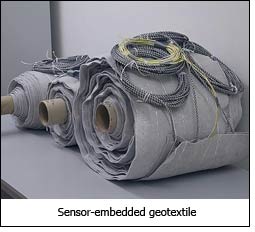Interviews
Technical textiles can help improve safety of built environment – Expert
18 Jul '09
5 min read

Sensor-embedded geotextile
Then we asked him whether commercial applications have begun on the same, to which he said, “Although the POLYTECT project is still ongoing, which means the project is still in the development phase, several important field tests and commercial applications are underway. In 2007, sensor embedded geotextiles were installed at the construction of a railway embankment in Chemnitz, Germany. Conducted during the winter months, the sensors all survived the construction phase (e.g. normal compaction operations) and are still working 18 months later”.
“Also in Germany, a client had the problem of a recurrent slope failure that is threatening nearby residences. A reconstruction effort is again underway and this time, sensor-embedded textiles will provide the ability to understand immediately if the repair has been successful and to better model the complex behaviour of the involved area if the soil continues to move. With respect to masonry applications, the recent earthquake in Abruzzo, Italy has highlighted the need for such reinforcing and monitoring solutions”, he added by saying.
“Technical textiles are being widely used to repair damaged structures and POLYTECT sensors-embedded textiles will be included in several of the newly constructed homes to demonstrate their potential. In the capacity of chemical monitoring, POLYTECT technical textiles are scheduled for installation at a landfill in Romania. In this capacity, the monitoring function provides the operational in-service conditions of the landfill to optimize its performance as a bio-reactor”, he concluded by saying.
To conclude the interview we asked him to gaze through a crystal globe and foresee the future of application of technical textiles in construction, to which he explained by saying, “Technical textiles will help us construct, manage, and operate civil infrastructure in a more optimal manner. As we understand the in-service performance of our structures better, we will be able to improve our codes and design methods. Maintenance and repair efforts will be conducted at the correct time”.
“Most importantly, these textiles can help improve the safety of the built environment. As we look to our structures to become more ecologically friendly, technical textiles also have the potential to replace more energy intensive construction materials and to also participate in energy harvesting efforts. Indeed and in conclusion, there is a promising future ahead and much work to do for technical textiles in construction”, he concluded by saying.
“Also in Germany, a client had the problem of a recurrent slope failure that is threatening nearby residences. A reconstruction effort is again underway and this time, sensor-embedded textiles will provide the ability to understand immediately if the repair has been successful and to better model the complex behaviour of the involved area if the soil continues to move. With respect to masonry applications, the recent earthquake in Abruzzo, Italy has highlighted the need for such reinforcing and monitoring solutions”, he added by saying.
“Technical textiles are being widely used to repair damaged structures and POLYTECT sensors-embedded textiles will be included in several of the newly constructed homes to demonstrate their potential. In the capacity of chemical monitoring, POLYTECT technical textiles are scheduled for installation at a landfill in Romania. In this capacity, the monitoring function provides the operational in-service conditions of the landfill to optimize its performance as a bio-reactor”, he concluded by saying.
To conclude the interview we asked him to gaze through a crystal globe and foresee the future of application of technical textiles in construction, to which he explained by saying, “Technical textiles will help us construct, manage, and operate civil infrastructure in a more optimal manner. As we understand the in-service performance of our structures better, we will be able to improve our codes and design methods. Maintenance and repair efforts will be conducted at the correct time”.
“Most importantly, these textiles can help improve the safety of the built environment. As we look to our structures to become more ecologically friendly, technical textiles also have the potential to replace more energy intensive construction materials and to also participate in energy harvesting efforts. Indeed and in conclusion, there is a promising future ahead and much work to do for technical textiles in construction”, he concluded by saying.
Fibre2fashion News Desk - India
Popular News
































-Ltd..jpg?tr=w-120,h-60,c-at_max,cm-pad_resize,bg-ffffff)





.jpg?tr=w-120,h-60,c-at_max,cm-pad_resize,bg-ffffff)
.jpg?tr=w-120,h-60,c-at_max,cm-pad_resize,bg-ffffff)






